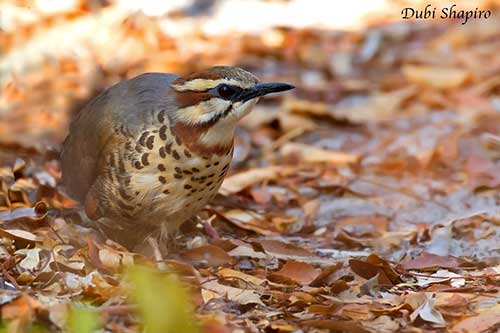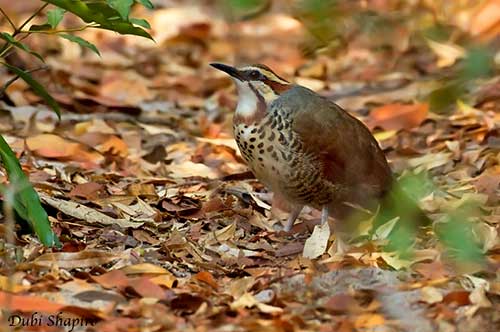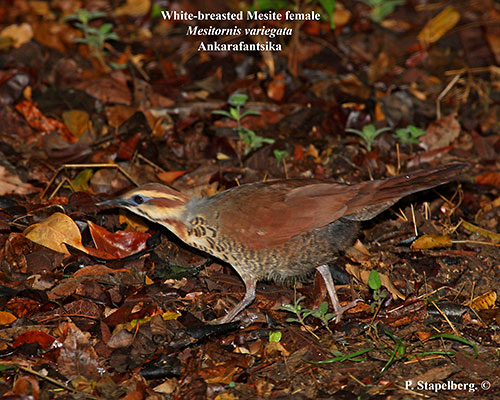
Fr: Mésite variée
Ang: White-breasted Mesite
All: Kurzfuß-Stelzenralle
Esp: Mesito Pechiblanco
Ita: Mesite pettobianco
Nd: Witborststeltral
Sd: vitbröstad mesit
Mal: Arefy, Pangalatrovy, Tolohon'ala
Photographer:
Dubi Shapiro
Dubi Shapiro Photo Galleries
Philip Stapelberg
GALLERY
Text by Nicole Bouglouan
Sources:
HANDBOOK OF THE BIRDS OF THE WORLD Vol 3 by Josep del Hoyo-Andrew Elliott-Jordi Sargatal - Lynx Edicions - ISBN: 8487334202
Birds of Madagascar: A Photographic Guide Par Pete Morris, Frank Hawkins – ISBN: 0300077556, 9780300077551- Editeur: Yale University Press, 1998
Birds of the Indian Ocean Islands Par Ian Sinclair, Olivier Langrand - ISBN: 1868729567, 9781868729562- Editeur: Struik, 2003
The Birds of Africa: Volume VIII: The Malagasy Region: Madagascar, Seychelles, Comoros, Mascarenes - Par Roger Safford, Frank Hawkins – ISBN: 1408190494, 9781408190494- Editeur: A&C Black, 2013
Creagus – Don Roberson - MESITES Mesitornithidae
White-breasted Mesite
Mesitornis variegatus
Mesitornithiformes Order – Mesitornithidae Family
INTRODUCTION:
The White-breasted Mesite is endemic to Madagascar. It is a terrestrial forest species which frequents undisturbed deciduous forest at some sites in N and W Madagascar, and one more in the east.
It usually lives in small groups with the members resting, feeding and preening together. It feeds on a variety of insects and seeds.
The White-breasted Mesite is threatened by degradation and destruction of forest, and hunting during the dry season when the young leave the nest and are vulnerable to predation. The small population is declining and the species is listed as Vulnerable.
DESCRIPTION OF THE BIRD:
Biometrics:
Length: 31 cm
Weight: 103-111 g
The White-breasted Mesite has chestnut-brown upperparts with grey nape in some birds. Flight-feathers and rectrices are slightly darker and the back is rufous-brown.
The underparts are buffy-white with black crescents on sides of breast and upper belly. We can see a rufous breast band that joins the black moustachial stripe. This breast band is variable in extent and tone in the northernmost population. However, this band is thick and brighter in the southernmost population. Chin and throat are white. Flanks and lower belly are darker with black crescents overall. On the underwing, the flight-feathers are brown with fine black markings.

The head is chestnut-brown with conspicuous buffy-white supercilium and malar area, and black moustachial stripe.
Unlike in the Subdesert Mesite, the blackish bill is almost straight and shorter. The eyes are dark brown, surrounded by grey/blue skin. The strong legs and feet are pale pinkish-grey.
The variability of the plumage is probably related to age and sex.
Male and female are similar.
The juvenile of 1-2 months old resembles adult, but it has yellow-buff throat and supercilium, with less distinct blackish marks.
RANGE:
The White-breasted Mesite occurs at three separated small areas on the island. It is present at sites in W and N, between Analamera and Menabe forests. There is a single record from Ambatokavy in the east.
HABITAT:
The White-breasted Mesite frequents the deciduous dry forest below 150 metres, and can be found locally in rainforest at 350 metres of elevation.
CALLS AND SONGS: SOUNDS BY XENO-CANTO
The White-breasted Mesite is more vocal during the breeding season, when the songs are used in territory defence. The bird gives a loud, whistled duet “weeeee titititi… weee titititi… titit wee titit weee… wee tititititi” which accelerates and becomes more excited, before falling away at the end. Both mates often sing in duet during 30-60 seconds, and male and female have different parts.
The contact call is a soft “see-see-see” usually given while feeding. Some “shik” notes are given in alarm.
The White-breasted Mesite sings all year round, and more during the breeding season.
BEHAVIOUR IN THE WILD:
The White-breasted Mesite feeds on invertebrates, usually insects, adults and larvae, such as crickets, cockroaches, beetles, mantids, moths and flies. Spiders are also taken.
During the dry season, the diet includes mostly seeds, but small vertebrates such as dwarf terrestrial chameleons are also part of the diet.
The White-breasted Mesite walks slowly and investigates suitable areas when foraging. It searches for prey in the leaf-litter by gleaning from the surface. It lifts up large leaves while looking for large insects. The rolled-up dead leaves are shaken to get some hidden prey. It may run to pursue some flushed invertebrates.

The White-breasted Mesite is often seen in pairs or small family groups, usually the pair and the most recent young. The species is monogamous with long-term pair-bond.
The members of a group co-ordinate activities such as feeding, resting or preening. Some disputes may occur over larger food items.
The territory is maintained and defended, but territorial encounters occasionally occur between groups. The adults are aggressive, flying up in the air, pecking and scratching at each other. The young members watch but do not participate. Loud singing competitions may occur too, instead of physical fights.
The adults are preyed upon by Henst’s Goshawk, and large snakes attack the nests. Other predators include rodents, both native and introduced (Rattus rattus). The Hook-billed Vanga may rob the nests too.
The White-breasted Mesite is sedentary on the island and holds the territory all year round.
This species flies only over short distances or when chased by humans or predator. The flight is performed with strong, noisy wingbeats over 20-30 metres, occasionally more, up to 80 metres, but rarely.
REPRODUCTION OF THIS SPECIES:
The mesites breed during the rainy season, with the laying between October and April.
The White-breasted Mesite nests in thin clumps of vegetation, 1-3 metres above the ground. The nest is a loose platform made with sticks and lined with some leaves and plant fibres.
The female lays 2-3 whitish to pale yellowish-brown eggs with variable reddish markings. The female incubates during the day, whereas the male incubates at night. The incubation lasts 25 days.
The chicks are red-brown. They are fed by both parents. The post-fledging period is probably long, more than one year, and the birds live as family groups. There is no evidence of co-operative breeding.
PROTECTION / THREATS / STATUS:
The White-breasted Mesite is threatened by habitat loss through slash-and-burn cultivation, uncontrolled fires and logging. It is affected by hunting pressure during the dry season and predation by dogs and introduced rodents.
The population is estimated to number 5,300 mature individuals and is decreasing rapidly.
The White-breasted Mesite is currently listed as Vulnerable.
